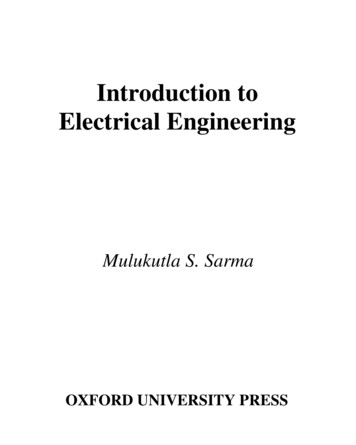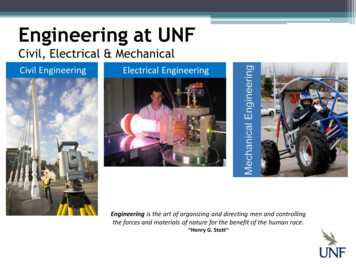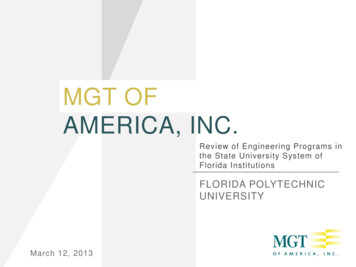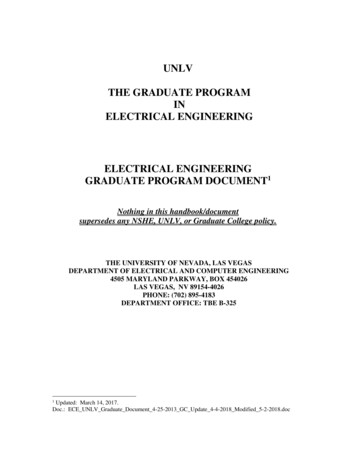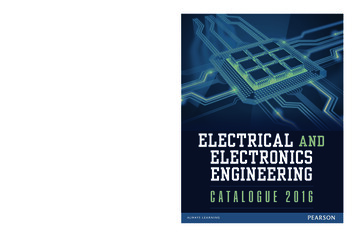
Transcription
Electrical andElectronicsEngineeringCATALOGUE 2016Electrical and Electronics EngineeringCATALOGUE 20167th Floor, Knowledge Boulevard, A-8 (A), Sector 62, NOIDA 201 309T: (91-120) 7110 100 I F: (91-120) 7110 350www.pearson.co.ininfoindia@pearson.comPearson India Education Services Private Limited (Formerly TutorVista Global Private Limited) Regd Off: Module G4, Ground Floor, Elnet Software City, TS-140, Block 2 & 9, Rajiv Gandhi Salai, Taramani, Chennai, Tamil Nadu 600113, CIN: U72200TN2005PTC057128Electrical andElectronicsEngineeringCATALOGUE 2016
Now available with Op-Amps and Linear Integrated Circuits9789332550230Oppenheim/Willsky/Hamid Signals and Systems29789332555082Streetman / BanerjeeSolid State Electronic Devices79789332550131Van ValkenburgNetwork Analysis39789332550162OgataModern Control Engineering59789332556065Helfrick & CooperModern Electronic Instrumentation & Measurement Technology19789332549883Jang / Sun / MizutaniNeuro-Fuzzy and Soft Computing: A ComputationalApproach to Learning and Machine Intelligence149789332559516RyderNetworks, Lines and Fields, 2/e29789332551770Jordan & BalmainElectromagnetic Waves & Radiating Systems29789332550087Liu / GibsonMicrocomputer Systems: The 8086/8088 FamilyArchitecture Programming and Design29789332551763Del ToroElectrical Engineering Fundamentals29789332556911CromwellBiomedical Instrumentation and Measurement29789332549661OgataDiscrete-Time Control Systems29789332550339Oppenheim / SchaferDigital Signal Processing19789332551916JainFundamentals of Digital Image Processing19789332549685TomasiAdvanced Electronic Communications Systems69789332555129Webb / ReisProgrammable Logic Controllers: Principles and Applications 5e59789332550483Coughlin & DriscollOperational Amplifiers and Linear Integrated Circuits 6e69789332549715KrishnanElectric Motor Drives: Modeling, Analysis, and Control19789332555136Proakis / SalehiCommunication Systems Engineering 2e29789332549937LewisFundamentals of Embedded Software with the ARM Cortex-M329789332555228FletcherAn Engineering Approach to Digital Design19789332555174RashidIntroduction to PSpice Using OrCAD for Circuits and Electronics 3e39789332550520Goodwin/Graebe/SalgadoControl System Design (With CD)19789332550551HuelsmanBasic Circuit Theory39789332550537Soliman/Continuous and Discrete Signals and Systems2Mandyam D. Srinath9789332550544ShotwellAn Introduction to Fiber Optics19789332550186HorensteinMicroelectronic Circuit and Devices29789332555266DomachIntroduction to Biomedical Engineering 2e29789332560123RabinerTheory and Application of Digital Signal Processing, 1/e19789332556928SocolfDesign and Applications of Analog Integrated Circuits19789332560130JohnsonIntroduction to Digital Signal Processing1
ContentsELECTRICAL ENGINEERINGAdvanced Control Systems.1Basic Electrical Engineering.1Control Systems.6Circuits and Networks.11Electric Machines (AC, DC and Special Machines).14Electric Drives.16Power Electronics.17Power Systems.19PSpice.22ELECTRONICS & COMMUNICATION ENGINEERINGAdvanced Communication Systems.24Advanced Digital Signal Processing.25Antenna Theory.28Basic Electronics.28Consumer Electronics.30Communication Systems(Analog and Digital).30Digital Electronics/Digital Design.37Digital Image Processing.44Digital Signal Processing.45
Digital Signal Processors.48Electromagnetics.48Electronic Devices & Circuits.53Fiber Optics Communication.59Electronic Instrumentation and Measurement .61Linear IC Applications.65Microcontrollers / Embedded Systems.67Microprocessors.75Microwave Engineering.79MATLAB.80Multimedia Communications.82Probability Theory and Stochastic Process.83Pulse & Digital Circuits.83Satellite Communications .84Signal and Systems.86Telecommunication.89VHDL.89VLSI Chip Fabrication.90VLSI Design.90Wireless Communications.93
Electrical EngineeringAdvanced Control SystemsAdvanced Control SystemsDesign, 1/eSystem Dynamics, 4/eBernard FriedlandKatsuhiko OgataISBN: 9789332559561Copyright: 2016Pages: 368ISBN: 9789332534971Copyright: 2013Pages: 784NewAbout the BookAbout the BookThis text presents students with the basic theory and practice of systemdynamics. It introduces the modeling of dynamic systems and responseanalysis of these systems, with an introduction to the analysis and design ofcontrol systems.Features NEW - Revised and expanded content throughoutNEW - Expanded and earlier presentation of state-space modeling—Chapter 5NEW - Added chapter on modeling dynamic systems—Chapter 4Use of MATLAB throughoutHundreds of examples and worked-out problems—With and troduction to System DynamicsThe Laplace TransformMechanical SystemsTransfer-Function Approach to Modeling Dynamic SystemsState-Space Approach to Modeling Dynamic SystemsElectrical Systems and Electromechanical SystemsFluid Systems and Thermal SystemsTime-Domain Analyses of Dynamic SystemsFrequency-Domain Analyses of Dynamic SystemsFrequency-Domain Analyses and the Design of Control SystemsTime-Domain Analyses of Control SystemsAppendix A. Systems of UnitsAppendix B. Conversion TablesAppendix C. Vector-Matrix AlgebraAppendix D. Introduction to MATLABStressing the importance of simulation and performance evaluation foreffective design, this new text looks at the techniques engineers use to designcontrol systems that work. It covers qualitative behavior and stability theory;graphical methods for nonlinear stability; saturating and discontinuous control;discrete-time systems; adaptive control; and more. For electrical engineersworking in modern control system design.Features KEY BENEFIT: Stressing the importance of simulation and performanceevaluation for effective design, this new text looks at the techniquesengineers use to design control systems that work.KEY TOPICS: It covers qualitative behavior and stability theory; graphicalmethods for nonlinear stability; saturating and discontinuous control;discrete-time systems; adaptive control; and more.MARKET: For electrical engineers working in modern control systemdesign.About the AuthorBernard Friedland, New Jersey Institute of TechnologyBasic Electrical EngineeringElectrical EngineeringFundamentals, 2/eVincent Del ToroISBN: 9789332551763Copyright: 1997Pages: 940NewAbout the BookElectrical Engineering Fundamentals focuses on the five principal zones withinthe discipline of electrical engineering. The author also develops new contentthat is more attuned to the needs of the students and uses new fundamentallaws to clarify the concepts and ideas in a more structured manner.The second edition of the book, Electrical Engineering Fundamentals isintended to be put in use where Del Toro’s other text, Principles of ElectricalEngineering is being used. As a text, although it is primarily designed forstudents of electrical engineering, non-majors can subscribe to the text easily1
because of its accessible content. The student can use the Classical Method orthe Laplace Transform Method to solve problems.The book is highly illustrative with 1500 figures & illustrations and 1400 solved/unsolved problems as well as 500 MCQ’s.ContentsFeaturesThe Fundamental Laws of Electrical Engineering.Part One: Electric Circuit Theory1. The Circuit Elements. Elementary Network Theory.2. Circuit Differential Equations:3. Forms and Solutions. Circuit Dynamics and Forced Responses.4. The Laplace-Transform Method of Finding Circuit Solutions.5. Sinusoidal Steady-State Response of Circuits.Part Two: Electronics6. Electron Control Devices:7. Semiconductor Types.8. Semiconductor Electronic Circuits.9. Special Topics and Applications.Part Three: Digital Systems10. Binary Logic: Theory and Implementation.11. Simplifying Logical Functions.12. Components of Digital Systems.13. Microprocessor Computer Systems.Part Four: Electromechanical Energy Conversion14. Magnetic Theory and Circuits.15. Transformers.16. Electromechanical Energy Conversion.17. The Three-Phase Induction Motor.18. Three-Phase Synchronous Machines.19. D-C Machines.20. Single-Phase Induction Motors.21. Stepper Motors.Part Five: Feedback Control Systems22. Principles of Automatic Control.23. Dynamic Behavior of Control Systems.24. Appendices.About the AuthorVincent Del Toro was an Emeritus Professor of City College of New Yorkand an Electrical Engineer. His other books include Electric Machines andPower Systems, Principles of Control Systems Engineering and Electric PowerSystems.He graduated from CCNY and Brooklyn Polytechnic University before turningto his enriching career in education and academics. He was a well-knowneducator and had garnered Educator of the Year awards for his contributionsin the field. He wrote 10 books along with the best-selling books ElectricalEngineering Fundamentals and Principles of Electrical Engineering. He died atthe age of 82 on July 5, 2006 in New Jersey.Electrical Technology :Volume ISurinder BaliISBN: 9788131785935Copyright: 2013Pages: 608About the BookThe book is written and organized in a very simple manner keeping in mindthe needs for today’s students. As the book introduces the subject with basicfundamentals like System of Units, Fundamentals of Electrons thereby helpingengineering students in building their concepts. The Volume 1 of the bookcomprises of 54 Chapters covering topics in three-parts, Part A covers ElectricalFundamentals, Part B: Electric Machines & Part C: Electric Measurements.2 Presents a comprehensive coverage on the fundamentals of the subject,such as Dielectric Materials, Electrochemical Action, Inductors, andHysterisis.Chapters focusing on magnetic materials, complex algebra, fourier series,first and second order systemsAdditional solved examples provided at the end of chapter for concreteunderstanding of topicsWeb Supplements includes animations, important formulae, periodicchart, key terminology, Diagrammatic Symbols etc.Excellent pedagogyoLearning ObjectivesoChapter Summaryo900 illustrationso450 solved questionso450 unsolved questionso300 MCQs with .16.17.18.19.20.21.22.23.24.25.26.27.28.29.30.Part A: Electrical FundamentalsSystem of UnitsElectrons in ActionElectric CircuitsSimple D.C. CircuitsNetworks (D.C.)Mesh Current and Node-Voltage AnalysisElectrochemical ActionElectromagnetismInductors and A.C. TransientsHysteresisMagnetic MaterialsElectrostaticsCapacitors and D.C. TransientsDielectric MaterialsField TheorySingle Phase Alternating Voltage and CurrentThree – Phase Circuits and SystemsComplex AlgebraWork, Power and EnergyPower Factor CorrectionLCR CircuitsResonanceThe Fourier SeriesNetworks (A.C.)Delta Wye TransformationsAttenuators and FiltersTransmission LinesFirst and Second Order SystemsLaplace TransformsCoupled CircuitsAbout the AuthorS. P. Bali has been associated with the field of electronics for over 45 years.With over 20 years of teaching experience, he has been teaching new entrantsin the field of electronics and taken diploma-level courses in the MilitaryCollege of Electronics and Mechanical Engineering (MCEME), Secunderabad.He has contributed articles to magazines and has authored several books.
Electrical Technology: Volume IISurinder BaliISBN: 9789332514416Copyright: 2013Pages: 456About the Book50.51.52.53.54.Ammeters, Voltmeters and OhmmetersWattmeters and Energy MetersMultimeters VOMs Analog and DigitalThe OscilloscopeOscilloscope TechniquesAbout the AuthorS. P. Bali has been associated with the field of electronics for over 45 years.With over 20 years of teaching experience, he has been teaching new entrantsin the field of electronics and taken diploma-level courses in the MilitaryCollege of Electronics and Mechanical Engineering (MCEME), Secunderabad.He has contributed articles to magazines and has authored several books.Electrical Technology, Volume 2 is the second offering of the bookon Electrical Technology and serve the need of undergraduate students ofelectrical and electronics engineering. The book is divided into two partsconsisting of 24 chapters. Part on Electric Machines introduces AC and DCmachines and Part on Electrical Measurements discusses various electricalinstruments and measurements.The book is also packaged with DoCircuits- a web-based circuit simulator,specially created to help students practice key circuits. It works acrossplatforms (Windows/Mac/Linux) and does not require any installation orplug-ins. Besides being used as a practice/pre-lab tool by students, it can alsoserve as an exciting tool for instructors to teach the circuits.Apart from the free version, the book is also accompanied with an access codeto avail the full version of DoCircuits at an exciting offer. The access details andcode are given on the inside front cover.Features Exhaustive coverage on rotating machines including AC, DC and specialmachinesDetailed discussion on synchronous generators and motors in separatechaptersEnd-of-chapter solved examples for concrete understanding of theconceptsWeb Supplements includes animations, important formulae, periodicchart, key terminology, Diagrammatic Symbols etc.Excellent pedagogyoLearning ObjectivesoChapter Summaryo500 illustrationso170 solved questionso380 unsolved questionso270 MCQs with .43.44.45.46.47.48.49.Part B – Electrical MachinesElectromechanical Energy ConversionD.C. GeneratorsD.C. MotorsEfficiency of Direct Current MachineryD.C. Motor ControlSingle Phase TransformersThree-Phase TransformersSynchronous Generators (Alternators)Synchronous MotorsInduction Motor (3 – Phase)Induction Motor (Single Phase)Specialized MotorsServos and SynchrosOpen - Loop and Closed – LoopConverters and InvertersControlled RectifiersPer – Unit SystemPart C – Electrical MeasurementsMeasurements and ErrorMeter MovementsEssentials of Electrical andComputer EngineeringDavid V. Kerns Jr.J. David IrwinISBN: 9788177580198Copyright: 2004Pages: 672About the BookWith its clear presentation of fundamentals in the context of variousapplications from all engineering fields, this text by proven authors representsthe best balanced general introduction to the field available. It introducesthe latest technologies such as MEMS (Microelectromechanical Systems) toillustrate how modern technologies are interdisciplinary.Features Large amount of examples and drill exercises and margin notes.Optional use of MATLAB as a computing tool.A lucid, readable discussion of digital technology.A large number of worked examples, drill exercises, and homeworkproblemsâ ”Designed to illustrate key principles.Coverage of the material and information needed to prepare for the FE(Fundamentals of Engineering) examâ ”A prerequisite for students whowant to pursue a Practicing Engineer 5.16.CircuitsIntroduction.DC Circuits.Transient Analysis.AC Steady State Analysis.Steady State Power Analysis.Magnetically Coupled Circuits and Transformers.Network Frequency Characteristics.ElectronicsIntroduction to Electronics.Operational Amplifiers (OpAmps).Semiconductors, Diodes, and Power Supplies.Transistor Fundamentals: Switches, Large-Signal Amplifiers and PowerElectronics.Small Signal Transistor Amplifiers.Digital Logic Circuits.Digital Electronic Logic Gates.ELECTROMECHANICAL SYSTEMSDC Machines.AC Polyphase Machines.3
Electrical Engineering:Principles & Applications, 6/ePearsonAllan R. HambleyISBN: TBACopyright: 2015Pages: 916ComingSoonFeatures About the BookElectrical Engineering: Principles and Applications, 6e helps students learnelectrical-engineering fundamentals with minimal frustration. Its goals are topresent basic concepts in a general setting, to show students how the principlesof electrical engineering apply to specific problems in their own fields, andto enhance the overall learning process. Circuit analysis, digital systems,electronics, and electromechanics are covered. Wide varieties of pedagogicalfeatures stimulate student interest and engender awareness of the material’srelevance to their chosen profession.Contents1 Introduction2 Resistive Circuits3 Inductance and Capacitance4 Transients5 Steady-State Sinusoidal Analysis6 Frequency Response, Bode Plots, and Resonance7 Logic Circuits8 Computers and Microcontrollers9 Computer-Based Instrumentation Systems10 Diodes11 Amplifiers: Specifications and External Characteristics12 Field-Effect Transistors13 Bipolar Junction Transistors14 Operational Amplifiers15 Magnetic Circuits and Transformers16 DC Machines17 AC MachinesDetailed coverage on AC Circuits and DC CircuitsStep-by-step problem-solving methodology to hone problem-solvingskillsExtended coverage on electric machines and measurementsCoverage on specialized motors like hysteresis motor, stepper motor,linear induction motor and universal motorIn-depth discussion on renewable sources of energy (eText)Separate chapters on Domestic Wiring and Illumination and Earthing andElectrical Safety (eText)Excellent pedagogyo700 Figures and Illustrationso450 Solved Questionso400 Unsolved Questionso300 MCQsContentsChapter 1 Concepts of Circuit TheoryChapter 2 DC Circuit Analysis and Network TheoremsChapter 3 Electrostatics and CapacitorsChapter 4 BatteriesChapter 5 Magnetic CircuitsChapter 6 AC FundamentalsChapter 7 Single-phase AC CircuitsChapter 8 Three-phase AC CircuitsChapter 9 Measuring InstrumentsChapter 10 Single-phase TransformersChapter 11 DC Machines (Generators and Motors)Chapter 12 Three-Phase Induction MotorsChapter 13 Single-Phase Induction MotorsChapter 14 Three-Phase Synchronous MachinesOnline ChaptersChapter 15 Sources of Electrical PowerChapter 16 Introduction to Power SystemChapter 17 Introduction to Earthing and Electrical SafetyChapter 18 Domestic Wiring & IlluminationAbout the AuthorDr. SK Sahdev Associate Dean Lovely Professional UniversityAbout the AuthorAllan R. Hambley received his B.S. degree from Michigan TechnologicalUniversity, his M.S. degree from Illinois Institute of Technology, and his Ph.D.from Worcester Polytechnic Institute. He has worked in industry for HazeltineResearch Inc., Warwick Electronics, and Harris Government Systems. He iscurrently Professor of Electrical Engineering at Michigan Tech.Basic Electrical and ElectronicsEngineeringS. K. BhattacharyaISBN: 9788131754566Copyright: 2011Pages: 740Basic Electrical EngineeringSK SahdevISBN: 9789332542167Copyright: 2015Pages: 768About the BookNewAttuned to the needs of undergraduate students of engineering in their firstyear, Basic Electrical Engineering enables them to build a strong foundation inthe subject. A large number of real-world examples illustrate the applicationsof complex theories. The book comprehensively covers all the areas taught ina one-semester course and serves as an ideal study material on the subject.4About the BookThis book provides an overview of the basics of electrical and electronicengineering that are required at the undergraduate level. Efforts have beentaken to keep the complexity level of the subject to bare minimum so thatthe students of non electrical/electronics can easily understand the basics. Itoffers an unparalleled exposure to the entire gamut of topics such as ElectricityFundamentals, Network Theory, Electro-magnetism, Electrical Machines,Transformers, Measuring Instruments, Power Systems, Semiconductor Devices,Digital Electronics and Integrated Circuits. Extensive use of illustrations,examples and exercises in accordance with the progressive development ofthe concepts covered within the chapter make the reading more exciting.
Features Covers syllabus prescribed by all universities.Easy to understand explanation of basic concepts.Also covers a Major Concepts from Basic Electronics – suitable foruniversities teaching Basic Electrical and Electronics together in one paperStep by step tutorial based approach.Excellent Pedagogy238 Solved examples754 Illustrations526 Unsolved Review questions314 Multiple choice 15.16.17.Basic Concepts, Laws, and PrinciplesDC Networks and Network TheoremsAC Fundamentals and Single-phase CircuitsThree-phase SystemElectromagnetism and Magnetic CircuitsTransformersDC MachinesThree-phase Induction MotorsSingle-phase MotorsSynchronous MachinesMeasurement and Measuring InstrumentsTransducersPower SystemsSemiconductor DevicesRectifiers and Other Diode CircuitsDigital ElectronicsIntegrated CircuitsHughes Electrical andElectronic Technology, 10/eEdward HughesIan McKenzie SmithDr John HileyKeith BrownISBN: 9788131733660Copyright: 2010About the BookAll engineers need to understand the fundamental principles of electricaland electronic technology. The tenth edition of this best-selling text offers aclear and comprehensive introduction to the area, with balanced coverage ofelectrical, electronic, and power engineering. This revision has been updatedto take into account key developments in the subject, including a new chapteron Electrical Energy Systems – an important addition which explores (amongother topics) the principles of sustainable electricity Section 1: Electrical PrinciplesInternational System of MeasurementIntroduction to Electrical SystemsSimple DC CircuitsNetwork TheoremsCapacitance and CapacitorsElectromagnetismSimple Magnetic CircuitsInductance in a DC CircuitAlternating Voltage and CurrentSingle-phase Series CircuitsSingle-phase Parallel NetworksPower in AC CircuitsComplex NotationResonance in AC CircuitsNetwork Theorems Applied to AC NetworksSection 2: Electronic EngineeringElectronic SystemsPassive FiltersAmplifier Equivalent NetworksSemiconductor MaterialsRectifiersJunction Transistor AmplifiersFET AmplifiersFurther Semiconductor AmplifiersInterfacing Digital and Analogue SystemsDigital NumbersDigital SystemsMicroprocessors and ProgramsControl SystemsSignalsData Transmission and SignalsCommunicationsFibreopticsSection 3: Power EngineeringMultiphase SystemsTransformersIntroduction to Machine TheoryAC Synchronous Machine WindingsCharacteristics of AC Synchronous MachinesInduction MotorsElectrical Energy SystemsPower SystemsDirect-current MachinesDirect-current MotorsControl System MotorsMotor Selection and EfficiencyPower ElectronicsSection 4: MeasurementsElectronic Measuring InstrumentsAnalogue Measuring InstrumentsHughes Electrical and Electronic Technology is a must-have text forall university and college engineering students requiring a comprehensiveintroduction to electrical and electronic engineering. It is also appropriate asa reference for any practitioners and technicians working in this, or any otherengineering discipline.Features Brand new chapter on Electrical Energy Systems including a detailedexamination of renewable energy sourcesUpdated and extended coverage in key areas such as Op-Amps;Induction Motors; and Fibre opticsEven more exercises and examples added to enhance problem solvingskills5
Control SystemsModern Control Theory, 3/eWilliam L BroganISBN: 9788131761670Copyright: 1990Pages: 736Control Systems Engineering,3/eS. K. BhattacharyaISBN: 9788131791653Copyright: 2013Pages: 604About the BookControl Systems is a comprehensive text, designed to cover the complete syllabiof this subject offered at various engineering courses at the undergraduate level.The book is also useful for students appearing for competitive examinationslike GATE, IAS, IES, NTPC, NHPC and so on.The book begins with a discussion on open-loop and closed-loop control systems.It goes on to discuss the block diagram representation and reduction techniques,which have been used to arrive at the transfer function of systems. This book laysemphasis on practical applications along with the explanation of key concepts.In this third edition, the treatment of topics has been made simple and lucid,with the help of extended derivations and an exhaustive number of newfigures, illustrations and solved examples.Features Routh’s criteria, Bode plot, Nyquist criteria and Root-Locus techniquediscussed in detail wi
Electrical Engineering Fundamentals focuses on the five principal zones within the discipline of electrical engineering. The author also develops new content that is more attuned to the needs of the students and uses new fundamental laws to clarify the concepts and ideas in a more structured manner. The se




